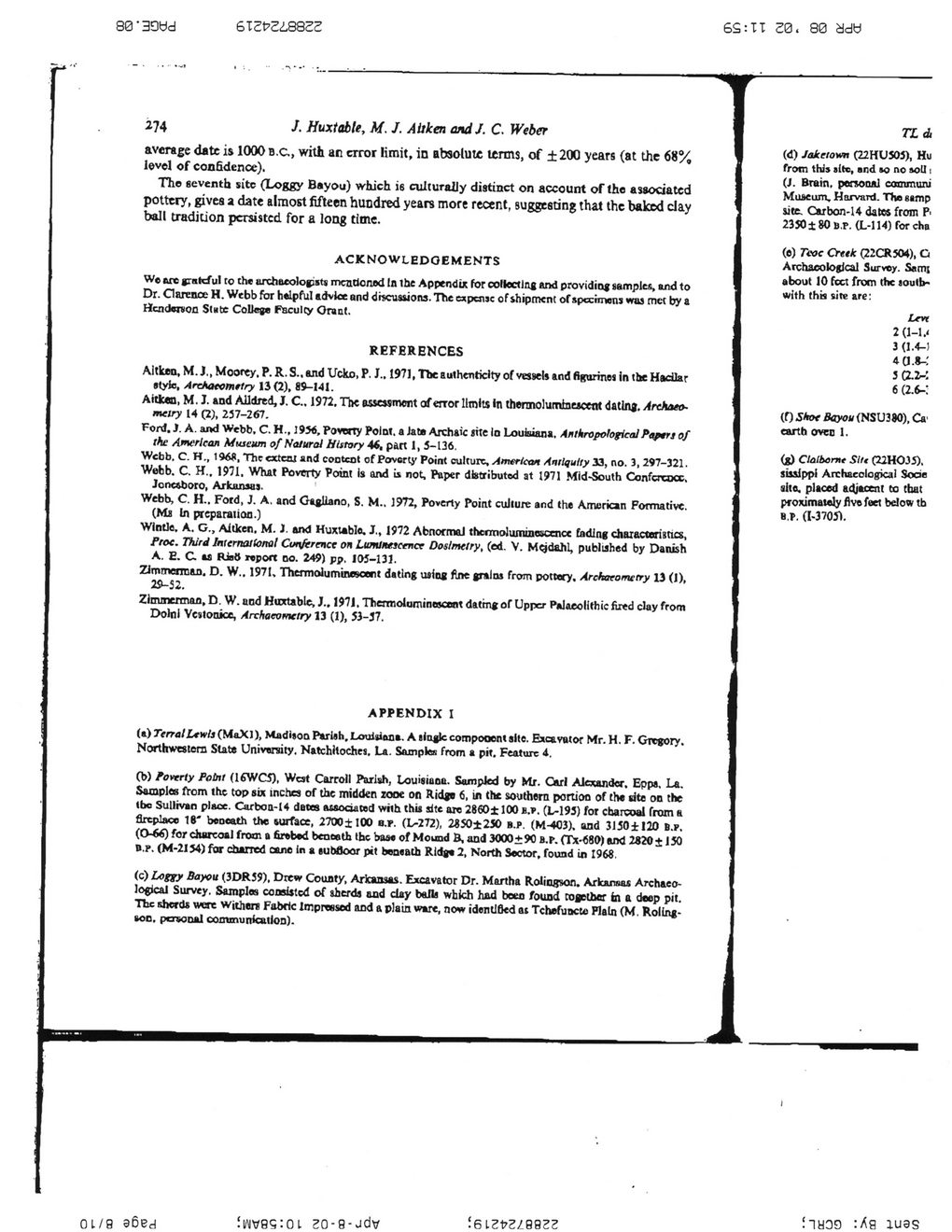This text was obtained via automated optical character recognition.
It has not been edited and may therefore contain several errors.
80' 30bd 6T2t?2i8822
6S:TI 20. 80 add
274
/. Huxtable, M. J. Aitken tmdJ. C. Weber
average date is 1000 B.C., with an error limit, in absolute terms, of ± 200 years (at the 68% level of confidence).
The seventh site (Loggy Bayou) which is culturally distinct on account of the associated pottery, gives a date almost fifteen hundred years more recent, suggesting that the baked clay ball tradition persisted for a long time.
ACKNOWLEDGEMENTS
We nre grateful to the archaeologists mentioned In the Appendix for collecting and providing samples, and to Dr. Clarence H. Webb for helpful advice and discussions. The expense of shipment of specimens was met by a Hcnderoon State College Faculty Orant.
REFERENCES
Altkea, M. J., Moorey, P. R. S.. and Ucko, P. J.. 1971, The authenticity of vessels and figurines In the Hadlar style, Archaeometry 13(2), 89-141.
Aitken, M. J. and AlldLrtd, J. C.. 1972, The assessment of error limits in thermoluminescent dating. Archaeometry 14 (2), 257-267.
Ford. S. A. and Webb. C. H., 1956, Poverty Point, a late Archaic »ite In Louisiana. AnthropologicalPetptrt of the American Museum of Natural History 46, part 1, 5-136.
Webb. C. H., 196$, The extea! and content of Poverty Point culture, American Antiquity 33, no. 3, 297-321. Webb. C. H., 1971. What Poverty Point Is and is not. Paper distributed at 1971 Mid-South Confcrcocc. Jonesboro, Arkansas.
Webb, C. H., Ford, J. A. and Gigliano, S. M., 1972, Poverty Point culture and the American Formative. (Ms In preparation.)
Wintle, A. G., Aitken, M. J. and Huxtable. J., 1972 Abnormal thcrmoluminewxncc fading characteristics, Ptoe. Third International Conference on Luminescence Dosimetry, (ed. V. Mgdahl, published by Danish
A. E. C. as HJaS report do. 249) pp. 105-131.
Zimmerman. D. W.. 1971. Thermoluminescent dating using fine grains from pottery. Archaeometry 13 (1), 29-32.
Zimmerman, D. W. and Huxtable, J.. 1971, Ttiernioluininescnit dating of Upper Palaeolithic fired clay from Dolnl VcstoaiGe, Archaeometry 13 (1), 53-37.
TL dt
(d) Jaketown (22HU505), Hu from this site, and to no soil i (J. Brain, personal catnmuni Museum. Harvard. The samp site. Carbon-14 dates from P' 2350 ± 80 B.P. CL-114) for cha
(e) Teoe Creek (22CR504), G Archaeological Survey. Sami about 10 feet from the toulh-with this site are:
Levt 2 {1-1.*
3 (1.4-1
4 a.*-: 3(2.2-: 6 (2.6-:
(0 Shoe Bayou (NSU380), Ca earth oven 1.
(g) Clalbemt Sift (22HOJ5), sissippl Archaeological Sobe site, placed adjacent to that proxitnaiely five feet below tb B.p. (1-3705).
APPENDIX I
(a) Terral Lewis (MaXl), Madison Pariah, Louisiana. A single compooent site. Excavator Mr. H. F. Gregory. Northwestern State University. Natchitoches. La. Samples from a pit. Feature 4.
(b) Poverty Point (I6WC5), West Carroll Parish, Louisiana. Sampled by Mr. Carl Alexander. Eppa. La. Samples from the top six inches of the midden zooe on Ridge 6, in the southern portion of the site on the tbc Sullivan place. Carbon-14 dates associated with this Site are 2860± 100 ».». (L-195) for charcoal from a fireplace 18' beneath the surface, 2700±100 e.r. (L-272), 2S50± 250 ».P. (M-403). and 315O±120 B.p, (0-66) for charcoal from a firebed beneath the base of Mound B, and 3000+90 b.p. (Tx-680) and 2820 4150
B.p. (M-2154) for charred cane In a subfloor pit beneath Ridge 2, North Sector, found in 1968.
(c) Loggy Bayou (3DR59), Drew County, Arkansas. Excavator Dr. Martha Rolingson. Arkansas Archaeological Survey. Samples consisted of sherds and clay balls which had been found together fai a deep pit. The sherds were withers Fabric Impressed and a plain ware, now identified at Tchefuacte Plain (M Rollng-son. personal communication).
01/9 a6ed
fwv9S:oi. 20-9-Jdv
‘.eizvzisszz !iho9 :Aa iuas

Claiborne Historical Site Archaeometry-Pp-269-275-(07)